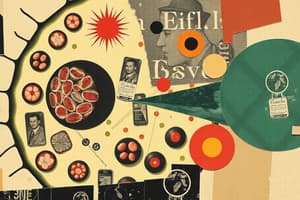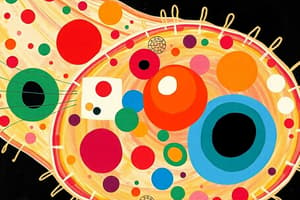Podcast
Questions and Answers
How does the structure of water molecules contribute to their polarity?
How does the structure of water molecules contribute to their polarity?
- The oxygen atom has a stronger attraction for electrons than the hydrogen atoms. (correct)
- Hydrogen and oxygen atoms share electrons equally.
- The oxygen atom has a slightly positive charge, while hydrogen atoms have a slightly negative charge.
- Water molecules form linear chains due to equal electronegativity.
What is the primary distinction between ionic and covalent molecules?
What is the primary distinction between ionic and covalent molecules?
- Covalent molecules are only found in living organisms whereas ionic molecules are not.
- Ionic molecules are formed through the sharing of electrons, while covalent molecules are formed through electrical attraction.
- Ionic molecules are formed from the combination of hydrophobic molecules and hydrophilic molecules, whereas covalent molecules are only hydrophobic.
- Ionic molecules are formed through electrical attraction, while covalent molecules are formed through the sharing of electrons. (correct)
How are the outer membrane of the nuclear envelope and the endoplasmic reticulum related?
How are the outer membrane of the nuclear envelope and the endoplasmic reticulum related?
- The outer membrane is generally continuous with the endoplasmic reticulum. (correct)
- They are completely independent structures with no physical connection.
- The outer membrane is formed from the proteins synthesized in the endoplasmic reticulum.
- They both contain the nucleolus.
What is the function of the nucleolus within the nucleus?
What is the function of the nucleolus within the nucleus?
What structural feature increases the surface area within the mitochondrion, and what is the significance?
What structural feature increases the surface area within the mitochondrion, and what is the significance?
If a cell were unable to produce lysosomes, what function would be impaired?
If a cell were unable to produce lysosomes, what function would be impaired?
What is the purpose of the endoplasmic reticulum?
What is the purpose of the endoplasmic reticulum?
What is the structural arrangement of flagella?
What is the structural arrangement of flagella?
Flashcards
Ionic Molecules
Ionic Molecules
Molecules formed by ionic bonds between atoms.
Covalent Molecules
Covalent Molecules
Molecules formed by covalent bonds, sharing electrons.
Nuclear Membrane
Nuclear Membrane
Two membranes surrounding the nucleus, continuous with the ER.
Nucleoplasm
Nucleoplasm
Signup and view all the flashcards
Chromosomes
Chromosomes
Signup and view all the flashcards
Lysosomes
Lysosomes
Signup and view all the flashcards
Cristae
Cristae
Signup and view all the flashcards
Thylakoids
Thylakoids
Signup and view all the flashcards
Study Notes
Cell Structure
- The oxygen atom in water (H₂O) has a stronger attraction to electrons in the H-O bond than the hydrogen atom does. Oxygen has a slightly negative charge, and hydrogen has a slightly positive charge.
- Covalently bonded molecules are called covalent molecules. Ionically bonded molecules are called ionic molecules.
- The nuclear membrane (also called the nuclear envelope) is made of two membranes. The outer membrane is often continuous with the ER and has ribosomes attached.
- The fluid inside the nucleus is called nucleoplasm.
- Chromatin condenses into thick rod-like structures called chromosomes during cell division, becoming visible under a light microscope.
- The nucleolus is a spherical particle found within the nucleus, not surrounded by a membrane. It's the site of ribosome synthesis.
- The inner membrane of the mitochondrion has convolutions called cristae.
- Small bodies in the cytoplasm that contain enzymes to break down cellular components are called lysosomes.
- Cavities of the endoplasmic reticulum (ER) that are channel-like or sac-like are called cisternae.
- The endomembrane system is a point within the cell where compounds are collected, concentrated, and where carbohydrates are synthesized.
- Protein synthesis takes place at ribosomes, composed of RNA and proteins, not surrounded by a membrane.
Chloroplast Structure
- The interior of chloroplasts is made up of many stacks of membranes called thylakoids.
- The flagellum is internally made up of double fibrils in a cylindrical ring around central single fibrils..
Cell Division
- Centrioles distribute daughter chromosomes to daughter cells during cell division.
Matching
- 5- Mitochondrion (powerhouse of the cell)
- 1 - Lysosomes
- 2 - Lacteals
Studying That Suits You
Use AI to generate personalized quizzes and flashcards to suit your learning preferences.




